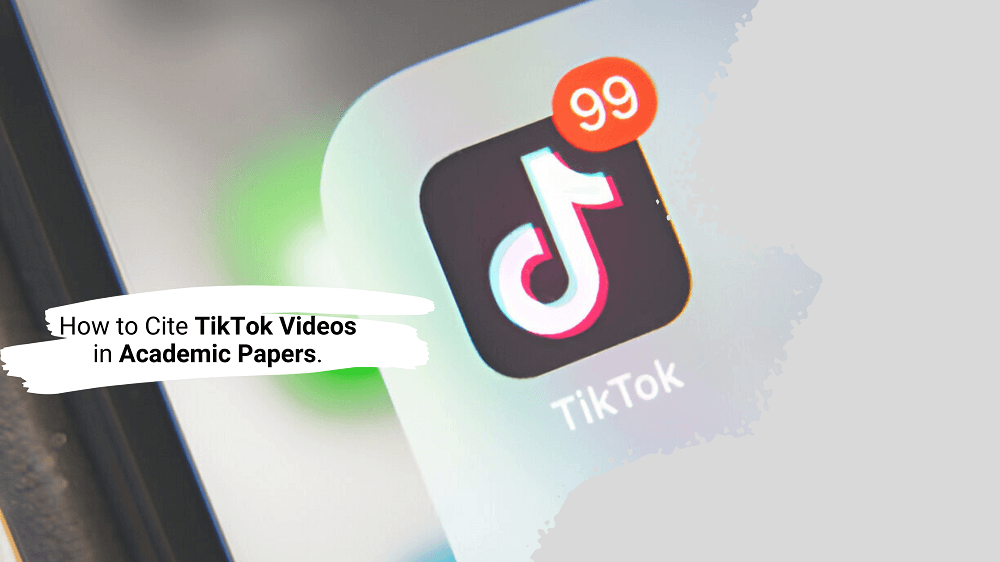
Social media platforms like TikTok are becoming unexpected yet valuable sources of information in academic research. Whether it is analyzing cultural trends, user behavior, or specific subject content, TikTok videos may offer rich and real-time data. However, how do you properly cite a TikTok video in your academic paper? This is a question we are sure comes up when you are assigned to write essays, research papers, term papers, or article reviews, any scholarly writing assignment.
In this quick guide, our expert writers explain the process, provides examples, and analysis of the best practices for citing TikTok videos in popular citation styles like MLA, APA, and Chicago.
Yes, you can cite TikTok videos in your academic paper, provided they are relevant to your research and meet the credibility standards required by your institution or discipline. TikTok videos are considered a legitimate source of information, particularly in fields such as media studies, sociology, information and library science, and digital culture. However, not all TikTok videos are created equal; it is crucial to evaluate the creator’s credibility, the content’s accuracy, and its relevance to your topic.
Most citation styles, including MLA, APA, and Chicago, now provide guidelines for citing social media content, allowing researchers to include TikTok in their bibliographies. Ensure you include all essential elements such as the creator’s handle, the video’s title or description, the platform (TikTok), the date of publication, and the URL.
For detailed guidance on citing social media content in different formats, check out this comprehensive guide to citing social media in academic writing. It offers tips and examples tailored to various citation styles, ensuring you stay compliant with academic standards.
Remember, while TikTok can provide unique insights, it is best used alongside peer-reviewed scholarly sources to maintain a balanced and credible argument in your paper.
There are many reasons that make TikTok a fertile place for getting informational references for facts, examples, and titbits for academic papers. Key among the reasons are the growing role of social media in academic research and the ethical and integrity considerations in academia.
TikTok is no longer just a platform for entertainment; it serves as a repository of educational content, grassroots movements, and unique societal insights. Scholars studying media, sociology, or current events increasingly turn to TikTok for research material. Proper citation ensures the credibility of your work while acknowledging the creator’s intellectual property.
Besides, proper citation is not just about format; it is an ethical responsibility. By accurately crediting creators, you uphold academic integrity and avoid potential plagiarism. Additionally, proper citations help readers locate and verify your sources, enhancing the transparency of your research.
In the realm of academic writing, students have the choice of picking a suitable formatting and citation style based on the subject and their field of study. Let us explore how to format TikTok videos in MLA, APA, and Chicago citation formats.
MLA style, widely used in humanities, emphasizes simplicity and clarity. A TikTok citation in MLA typically includes:
Example:
@educator.ideas. “Tips for Effective Studying.” TikTok, 5 Jan. 2025, www.tiktok.com/@educator.ideas/video/1234567890.
@tiktoker. “The Science of Memory Retention.” TikTok, 5 Jan. 2025, www.tiktok.com/@tiktoker/video/9876543210.
APA style, commonly used in social sciences, focuses on precision and publication date. An APA TikTok citation includes:
Example:
EducatorIdeas. (2025, January 5). Tips for effective studying. TikTok. www.tiktok.com/@educator.ideas/video/1234567890
Tiktoker. (2025, January 5). The science of memory retention. TikTok. www.tiktok.com/@tiktoker/video/9876543210
Chicago style offers flexibility, accommodating both notes and bibliography formats. A Chicago citation for TikTok typically includes:
Example:
EducatorIdeas, “Tips for Effective Studying,” TikTok, January 5, 2025, www.tiktok.com/@educator.ideas/video/1234567890.
Tiktoker, “The Science of Memory Retention,” TikTok, January 5, 2025, www.tiktok.com/@tiktoker/video/9876543210.
Citing TikTok videos accurately requires careful attention to detail, as each piece of information plays a vital role in creating a complete and reliable reference.
Unlike traditional sources, TikTok videos are dynamic and may lack formal titles or detailed metadata. Therefore, you need a structured approach to ensure your citation is accurate and comprehensive.
This also helps in ensuring your source (the video) aligns well with the guidelines of your chosen citation style. Below is a systematic breakdown of the details you need to collect:
When you get all these aspects right, you have everything needed to create a robust citation that aligns with MLA, APA, or Chicago style requirements.
Beware of the common mistakes that most students make when citing social media such as X(formerly Twitter), Facebook, Instagram, and other content. Here are the mistakes to avoid:
To avoid these mistakes, you need to adhere to the following best practices:
There is no limitation of what ideas you can borrow from TikTok creators into your academic paper. As long as it fits the context, theme, perspective, and purpose of your paper, you can integrate the material into your paper.
As social media platforms like TikTok become integral to modern scholarship, the ability to cite these sources accurately and responsibly is vital. By following the guidelines outlined above, you can maintain academic integrity while leveraging TikTok’s unique offerings in your research.
For further insights, explore related topics like:
While you might now be confident to cite a video on TikTok in your paper, ensure that you do it responsibly and professionally. If you are writing an academic paper - thesis, proposal, research paper, or essay and feel stuck, you can count on our online paper writers to help you. Hire professional academic writers to write the paper, integrate the right scholarly sources, and give you an error-free, plagiarism-free, and authentic, high-quality paper.
